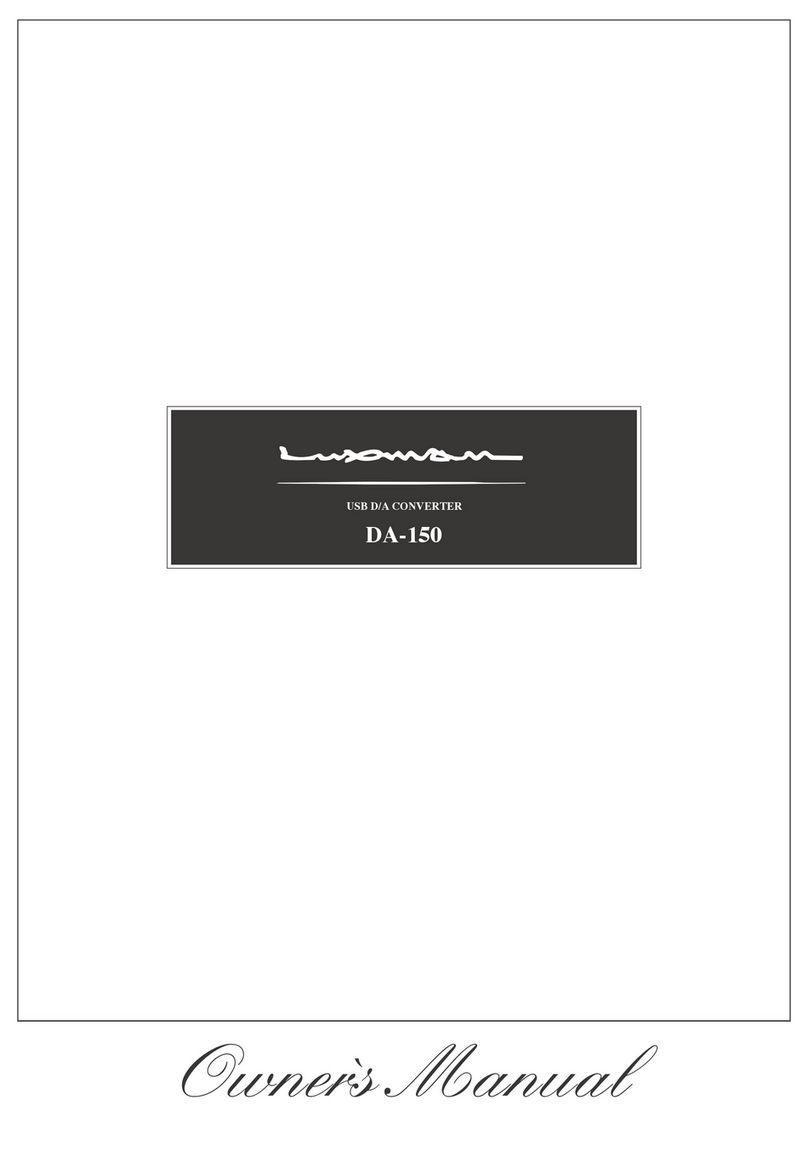USB D/A CONVERTER DA-200
7
12. Analog balance output terminals (XLR)
These are XLR output terminals used for the balanced play-
back output signals from this unit.
These terminals does not output the playback signals from
a device connected to the analog input terminals (LINE-1/
LINE-2) of this unit. Besides, the level of the playback output
signals is always fixed regardless of the state of the line out-
put level fix/variable selection switch (FIX/VARIABLE).
The following are the polarities of output terminals of this
unit.
1. GROUND
2. COLD (–)
3. HOT (+)
13. Digital input terminal (USB)
This is a USB 1.1 (B-type) input terminal used for the digital
input signal from such device as a PC/Mac using a USB
cable.
The terminal is applicable to the following data.
Sampling frequency: 32 kHz, 44.1 kHz, 48 kHz,
88.2 kHz, 96kHz, 176.4 kHz,
192 kHz
Number of quantization bits: 16 bit, 24 bit
However, a digital signal of 88.2 kHz, 176.4 kHz, or 192
kHz is input, the sampling frequency is internally converted
into 96 kHz.
14. Digital input terminal (COAX)
This is an RCA input terminal used for the digital input signal
from such device as a CD player equipped with digital out-
put terminals using a coaxial digital cable.
The terminal is applicable to the following data.
Sampling frequency: 32 kHz, 44.1 kHz, 48 kHz,
88.2 kHz, 96kHz, 176.4 kHz,
192 kHz
Number of quantization bits: 16 bit, 20 bit, 24 bit
15. Digital input terminal (OPT)
This is a TOS-LINK input terminal used for the digital input
signal from such device as a CD player equipped with digital
output terminals using an optical digital cable.
The terminal is applicable to the following data.
Sampling frequency: 32 kHz, 44.1 kHz, 48 kHz,
96 kHz, 176.4 kHz, 192 kHz
Number of quantization bits: 16 bit, 20 bit, 24 bit
16. Digital output terminal (COAX)
This is an RCA output terminal used to output the digital sig-
nal that has been input from the digital input terminal (OPT/
COAX/USB).
The digital input signal selected by rotating the input selec-
tor is output. The sampling frequency and the number of
quantization bits of the digital output signal are the same as
those of the input signal.
The playback signals from analog input terminals (LINE-1/
LINE-2) are not output from this terminal.
17. Digital output terminal (OPT)
This is a TOS-LINK output terminal used to output the digi-
tal signal that has been input from the digital input terminal
(OPT/COAX/USB).
The digital input signal selected by rotating the input selec-
tor is output. The sampling frequency and the number of
quantization bits of the digital output signal are the same
as those of the input signal, but since the channel status
indicating the digital format is reset only when the signal is
output from this terminal, the sampling frequency may be
displayed as 44.1 kHz on the D/A converter connected to
this unit.
The playback signals from analog input terminals (LINE-1/
LINE-2) are not output from this terminal.
Relational table of the input and output of DA-200
Output
Input
Headphone
output
Line output
Digital output
RCA XLR
OPT/COAX
Digital
input Variable Variable/
Fixed Fixed Available
Analog
input Variable Variable/
Fixed
Not
available
Not
available
18. AC inlet (AC IN)
Connects the accessory power cable. The power shall be
supplied from a household wall outlet.





























